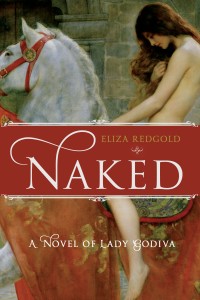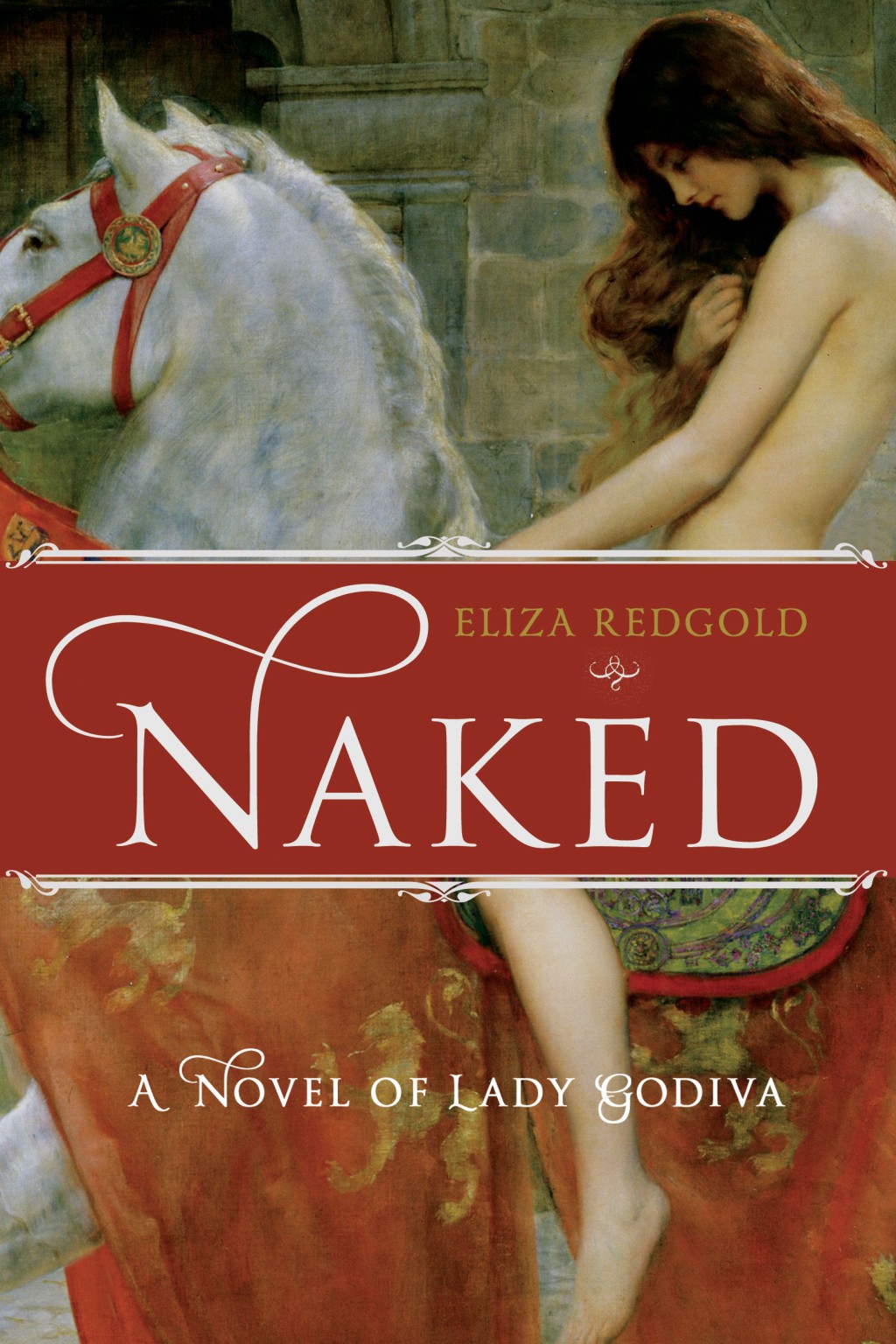It’s a great pleasure to have Eliza Redgold on my blog today, with a fascinating article on one of her great heroines. Eliza describes herself as “an author, academic and unashamed romantic” (I love her already), and her new novel Naked: A Novel of Lady Godiva was released by St Martin’s Press in 2015.
Lady Godiva – Feminist Freedom Rider
Lady Godiva has been called a feminist icon. She has inspired women for centuries. Find out why.

So the Powers, who wait
On noble deeds, cancell’d a sense misused;
And she, that knew not, pass’d: and all at once,
With twelve great shocks of sound, the shameless noon
Was clash’d and hammer’d from a hundred towers,
One after one: but even then she gain’d
Her bower; whence reissuing, robed and crown’d,
To meet her lord, she took the tax away
And built herself an everlasting name.
Alfred, Lord Tennyson: Godiva (1842)
The legend of Lady Godiva, who famously rode naked through the streets of Coventry covered only by her long, flowing hair, has lasted for centuries. So the story goes, she begged her husband, Lord Leofric of Mercia, to lift a high tax on her people, who would starve if they were forced to pay. Lord Leofric demanded a forfeit: that Godiva ride naked on horseback through the town. It’s something many 21st century women might baulk at, even for charity – calendar girls aside. There are various happy endings to Godiva’s ride; that all the people of Coventry closed their doors and refused to look upon on their liege lady, and that her husband, in remorse, lifted the tax. Other additions to the tale include the famous peeping Tom, the only one of the townsfolk who couldn’t resist a glance, and was struck blind.
Godiva’s tale has been revived and romanticized time and time again, especially during periods of change and liberation in women’s lives. It was in the Middle Ages during the age of courtly love, romance and chivalry, that Godiva’s story became legend, first appearing in Roger of Wendover’s Latin chronicle. During this period romance was spreading like wildfire through the courts of Europe, flourishing in female-dominated courts in France like that of Eleanor of Aquitaine and her daughter Marie of Champagne, thus giving rise to romance being dubbed ‘the first form of feminism’. Romance also ruled in the spiritual realm, and such was the source of its power. The medieval romancing of the Godiva story demonstrates this in what Robert Graves referred to as the medieval Godiva ‘cult’. According to Graves, Godiva reflected more than a woman or a saint – she was a medieval manifestation of the pagan Goddess, re – or rather, unclad.
The Lady Godiva legend next gained vogue in the 19th century with the Pre-Raphaelites and their followers and with poets such as Alfred, Lord Tennyson. This revival occurred just prior to the 19th century suffrage movement or first wave of feminism. A more saintly, demure Godiva appeared at this time than in the Middle Ages. In 19th century renditions, though often nude and still provocative, she rides forth “clothed on with chastity” as Tennyson put it in his famous 1842 poem, but in some 19th century portraits of the lady, she rides fully clothed.
Today, in the 21st century, at the ebb of second wave feminism and the turn of the tide towards the third wave, there is renewed cultural interest in Lady Godiva. In NAKED: A Novel of Lady Godiva, I aimed to capture her as a heroine and an inspiration to women. Godiva certainly deserves credit as feminist freedom fighter. Her legend has stood the test of time, to be transformed again and again. Her story has come down to us through the ages in a mix of fact, folk-lore and legend. Whatever the facts, she has remained captivating.
Lady Godiva of Coventry was a unique woman and a heroine in more ways than one: as sexual symbol, spiritual icon and political activist. Her return today heralds a new kind of feminist freedom. Her courage continues to inspire, her tale to be told, even after a thousand years.
NAKED: A Novel of Lady Godiva is available in all good bookstores and online.
Follow Eliza Redgold on
Twitter: @ElizaRedgold
or subscribe to her newsletter
Eliza Redgold: Biography
 ELIZA REDGOLD is an author, academic and unashamed romantic. She writes historical fiction (St Martin’s Press) and romance (Harlequin).
ELIZA REDGOLD is an author, academic and unashamed romantic. She writes historical fiction (St Martin’s Press) and romance (Harlequin).
NAKED: A Novel of Lady Godiva was released internationally by St Martin’s Press New York in 2015. Her ‘Romance your Senses’ series of contemporary romances are published by Harlequin. They include Black Diamonds, Hide and Seek and Wild Flower. Eliza is also contracted to Harlequin Historical for two upcoming Victorian historical romances. Look out for Enticing Benedict Cole in November 2015.
Eliza Redgold is based upon the old, Gaelic meaning of her name, Dr Elizabeth Reid Boyd. English folklore has it that if you help a fairy, you will be rewarded with red gold. She has presented academic papers on women and romance and is a contributor to the forthcoming Encyclopedia of Romance Fiction. She was born in Irvine, Scotland on Marymass Day and currently lives in Australia.
* * *
Thanks so much for the fascinating post, Eliza. I remember the story of Lady Godiva from learning about it at school, but hadn’t realised just how much it’s influenced authors and artists down the years. How interesting to turn her great story into a novel. I look forward to reading NAKED: A Novel of Lady Godiva very much!
If you’ve enjoyed Eliza’s post, or have any questions or comments at all, we’d love to hear from you!


Leave a Reply